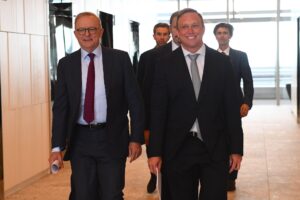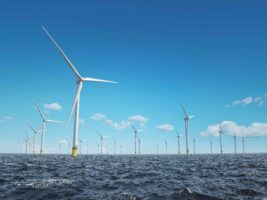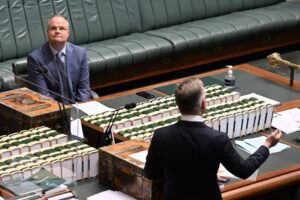Australia’s only domestic manufacturer of PV modules, Tindo Solar, says Australia is still “milling around the starting line” on establishing a domestic solar supply chain, thanks to years of industry and government focus on “lowest possible cost, all the time.”
In an address to the Smart Energy Conference in Sydney on Wednesday, Tindo Solar chief Richard Petterson said that after 14 years in business, including the launch a new 150MW factory 18 months ago, the company is still essentially “at square one.”
“We’re still the only ones doing it,” Petterson told the conference.
“We have been at it for 14 years. It has been really hard and tricky. And we often get criticised; why are we so small?
“It’s because the market is so ferociously competitive. And there has been zero support, really, except for one small federal government contribution [back when they were building the new factory].
“So really, we’re at square one.”
It’s not where Tindo wants to be. In January, the company unveiled plans to build a solar panel “gigafactory” in Australia, in response – Petterson said at the time – to the federal government’s call to establish home grown industry.
Tindo puts the cost of the new gigafactory, which would be capable of turning out 1.9 million panels a year and would generate around 250 jobs, at around $100 million – and government contributions to this cost will be crucial.
“We seek to to select the best technologies around the world to make the best product for Australia,” Petterson said this week.
“So scaling that… is a challenge because we are focused on that point of difference of making a high quality panel that performs extremely well.”
And with the cost of solar plummeting over the past year thanks to relentless supply of cheaper and cheaper panels coming out of China, the challenge for companies like Tindo is only getting tougher.
Last month, South Korea based QCells abruptly announced it was quitting the Australian market, after years spent building a local presence, including with the 2022 launch of an “end-to-end” solar and battery-based offer through a new retail entity called Arcstream.
“This decision is based on the context of the Australian solar market facing record breaking price drops and extreme market competition over the last 12 months,” a statement from Hanwha QCells Australia said.
Meanwhile, in the US market, the company has begun production at a new solar panel factory in Georgia that can turn out 5.1GW of PV a year.
“In the US, their stance is pro-business; they throw their arms open and find ways to help you do it. And they have funding. If you look at what the IRA’s doing right now the amount of investment it is sucking into their country is staggering,” Petterson told the Smart Energy Conference on Wednesday, after noting QCells’ exit.
And he says that something has got to give if Australia wants to have any hope of getting a foothold in the solar supply chain.
“Anyone that’s really in this race is already halfway down the track. We’re still milling around the starting line.
“We’re driven by the lowest possible cost, all the time. …We are too comfortable in Australia. We are comfortable investing in assets that you can see at the end of the day, so there’s always lots of money from wind farms and solar farms.
“We are uncomfortable with investing in manufacturing or industry that has risks associated with it. Our risk appetite is far too low, as a country, to get to where we need to. And that means we might invest in something that’s going to fail.”
That said, Petterson believes investing in construction of a solar panel gigafactory in one of Australia’s regional centres, like the Hunter in NSW, is a pretty safe bet, promising fast results and hundreds of jobs.
“The great thing about solar power module manufacturing is it’s deployable very quickly. So if we get the conditions right, if the government gets the conditions right, we believe we can have this facility up and running at scale within 18 months.
“We also believe it will be a catalyst for other things …. Activity creates activity, there’s no doubt about that.
“While we’re ruminating, thinking about it, talking a lot – there’s a lot of talk about what the country should do – everyone else is getting on with it. Like, there’s no other country sitting on their hands here at the moment.
“My point is that if you’re not willing to take on a high risk appetite … we’ll be standing here in a couple of years time with a very small industry.
“[But] if we start taking steps forward progressively and do that intelligently, we’ll look back in 10 years time and we’ll be standing on top of the industry.
“It’ll look very different to what we imagine right now … the opportunities change and the risks change every day of the week, particularly this industry. But we have to do one thing and that is take action.”










